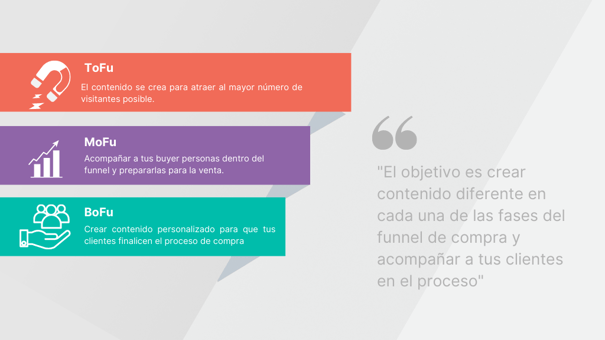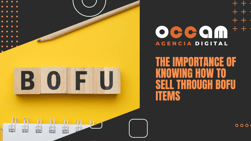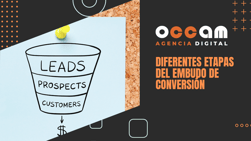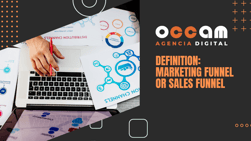Index Content
have you ever heard these terms ToFu, MoFu and BoFu? As much as they have a strange name, they are actually acronyms for Top, Middle and Bottom of the funnel and refer to the stages of the conversion funnel to which our inbound marketing strategy or tactic applies.

what is the conversion funnel and why is it so important in an Inbound Marketing strategy?
The conversion funnel is an online marketing concept that is directly related to the objectives set when opening an online shop, usually a website or a blog, especially if the objective is commercial. It defines the various stages or actions that each visitor to our website must perform to achieve a specific goal: usually become a registration or lead, or complete the purchase of a product or service.
Analysing and studying our conversion funnel allows us to know what the bounce rate of our site is at each stage in order to find a solution. In addition to its measurement function, it helps us to optimise our programmes at different stages. Then, for each user action, we will personalise the content according to the stage they are in, so that they can make the best decision based on the content they receive.
It is important that the sales and marketing departments communicate and work towards common goals. As our site evolves, the types of leads that reach the sales team will be well prepared to sell and the sales team will have little difficulty closing deals. This helps us calculate the return on investment (ROI) of the campaign. One of the most common mistakes in online marketing campaigns, especially in inbound marketing, is to focus on capturing the most customers, i.e. placing users at the top of the funnel, so we sometimes forget to improve the relationship with existing customers.
Discover all the benefits of the conversion funnel, in our detailed blog article in which we describe and analyse each of its phases.
why do we relate conversion rate to a funnel?
It is clear that a marketing campaign, whatever its nature, has the capacity to reach many people and even go viral. But it is also clear that not all the people who receive this content are going to become customers. During this process, they are going to abandon and remain exclusively potential leads. Hence, it has the shape of a funnel, it serves as a sieve to get the best customers, loyal to your brand.
ToFu, MoFu and BoFu are three concepts to take into account in the conversion funnel of the inbound marketing strategy. Join us in defining each of the phases of this process:
- ToFu (Top of the funnel). In this first phase, the user discovers that they have a need and begins to search the Internet for a product or service that satisfies it. The first thing is to inform the brand and see if they can solve your problem. Therefore, at this stage it is recommended to multiply:
- Blog posts: there you can talk about news or market trends.
- Posts on social networks: invite your followers to interact to generate engagement, such as Instagram, Facebook, Twitter, TikTok, LinkedIn...
- Tutorial-type videos: in them, you should explain how you use your product.
- Mofu (Middle of the funnel): The second phase consists of converting visits and followers into potential customers. To convert that visit into a lead, offer them specialised content in exchange for leaving you their contact details, such as their email or telephone number, on your landing page. Some of the most attractive things to make this happen are:
- Webinars: to educate potential customers and discuss the benefits of buying services or products.
- E-books: delve into topics of interest to your target audience and keep readers engaged.
- Events: as long as they are interesting or engaging and contextualise potential customers and satisfy their curiosity.
- Bofu (Bottom of the funnel): In the third and final stage of the sales funnel, the goal is to finally complete the conversion. This is the moment when potential customers are considering a purchase and comparing your offer with that of your competitors. This is why it is important to provide content that helps them make purchasing decisions, for example:
- Product demos or free trials: so that users can evaluate whether it is what they are looking for. This is one of the most effective techniques because everyone wants to get something for free and can buy it.
- Success stories: previous so that future users can test if your services and products work.
- Discounts: to encourage purchases.
When our customers have crossed all the processes of our conversion funnel, it's time to measure and analyse subsequent customer interactions with your product in order to understand their specific interests and what drives them to buy. By profiling our customers' personalities and behaviours, we are able to refine our precepts to increase sales volume.
If they have become a customer, i.e. they have made a sale and thus the company has achieved its main objective. Remember, our goal of building a conversion funnel strategy has allowed us to gradually attract potential customers and turn them into loyal customers. Report on all strategies during the ToFu, MoFu and BoFu phases and be critical, so that we know how to further optimise our campaigns.
If your users trust everything you create during your marketing strategy, it will be easier for you to move on to the next stage of inbound marketing. They will also respond better to your future communications because they trust and consider you as an expert. Brand credibility is the next step in your inbound marketing strategy. Make your customers familiar with your company and make them active leads who promote your brand.





